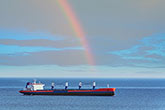The Panama Canal Port Authority have addressed the issue of water shortage head on
Published by Oliver Kleinschmidt,
Editorial Assistant
Dry Bulk,
The Panama Canal Port Authority has dedicated extensive research and investments to the management of its canal. However, 2023 has recorded some of the highest temperatures in history, causing far-reaching consequences for millions around the world.
For the Panama Canal, it has been no different. Elevated temperatures in the Atlantic Ocean, compounded by the presence of the El Niño phenomenon and the delayed onset of the rainy season, have directly impacted the levels of freshwater in the Canal’s reservoirs, which are essential for its operations.
The Panama Canal takes the issue of water scarcity very seriously and is committed to exploring all solutions available to minimise the impact on its operations. The current operational strategy has been focused on saving water while ensuring reliability on transit for operators and customers around the world.
As of the final week of November, all transits that have been booked ahead of time are going through the Canal on schedule. That is why the Port Authority has asked customers to make reservations ahead of time, so the measures put in place are reliable for everyone.
The current operational and water saving strategies are focused on critical steps, including:
Adjusting the maximum draft and daily transit capacity
The lack of rainfall in the Panama Canal Watershed made it necessary to reduce the number of daily transits, while managing the available water to maintain Gatun Lake at a level that allowed the continued offering of a competitive draft for customers and, above all, to maintain the availability of water necessary to supply the population. As in every dry season, draft restrictions were also announced at the waterway. Subsequently, vessels transiting the neopanamax locks are allowed maximum drafts of up to 44 feet, while vessels transiting the panamax locks have had no draft restrictions.
Managing water shortage
At the panamax locks, the Canal has found ways to reuse water from one lock chamber to another and has incorporated this technique as part of its daily operations. This maneuver, known as cross-filling, saves the equivalent consumption of six daily transits.
Planning and communicating in advance
Despite all measures taken, the level of Gatun Lake has continued to decline to unprecedented levels for the winter season. Precipitation in October was the lowest on record for the month since 1950, coming in 41% below expected levels. So far, 2023 is on par to become the second driest year on record. The hydrological department has provided updates on the watershed situation and a projection of water consumption, under multiple scenarios given the poor rainfall experienced so far and expected in the upcoming months. Based on its forecasts, the Canal determined that a gradual reduction to 18 daily transits would be necessary to ensure water for human consumption and business continuity during the upcoming dry season. As always, the Canal has announced these changes far in advance to ensure ships can adapt long before departing for the waterway. Additionally, customers are provided with real-time information to make their business decisions.
In addition to these water-saving measures, the Canal has explored additional shorter-term solutions to help optimise the use and storage of water at the Canal. One such project is already in the tender process and will improve the use and reliability of water stored at Gatun Lake.
Other measures include tandem lockages, with two ships transiting at the same time occupying one chamber, whenever the size of the vessels allows it. Furthermore, the transit schedule has been optimised to maximise water savings in each chamber and accommodate the highest number of vessels. In the neopanamax locks, the direction and scheduling of transits are analysed to make the most of every drop of this resource.
Additional procedures, such as the incremental usage of water saving basins in neopanamax locks; short chamber lockage in panamax locks when vessel dimensions allow it; minimal changes of direction in the Gatun locks; stricter control of water leaks in valves and gates; suspension of hydraulic assistance during lockages; and maintaining Lake Miraflores at its maximum operating level, all add up to saving as much as 50% of this resource.
The search continues for a set of long-term, concrete solutions
In recent years, the implementation of a more robust water management system has become a critical priority and a series of potential solutions have been studied, looking first at options within the Canal’s jurisdiction. However, the waterway’s specialists — in conjunction with US Army Corps of Engineers (USACE) — have confirmed that technical solutions within the Panama Canal’s jurisdiction are not sufficient to meet the growing demand for water. Instead, a set of solutions will need to be pursued, some of which fall outside of the Panama Canal Watershed.
Advancing any solutions outside the Canal Watershed requires approval from the Panamanian government. Therefore, the Board of Directors, as part of its mandate, delivered a proposal to the government to advance this process in September. The proposal focused on two key asks:
- Define the Canal Watershed and modify or expand the limits established in Law 20 of 2006
- Eliminate the restrictions imposed on the Canal in Law 28 of 2006 for the construction of new reservoir
Panama and the Panama Canal continue to offer unsurpassed advantages to the world’s maritime commerce due to its strategic geographic location. The Panama Canal aims to continue to uphold its role as a path between seas.
There is no simple answer or project that can immediately solve the challenge of water. In the meantime, the Canal will continue to serve more than 180 maritime routes, connecting 170 countries and reaching approximately 1920 ports in the world.
Click here for free registration to Dry Bulk
Read the article online at: https://www.drybulkmagazine.com/ports-terminals/30112023/the-panama-canal-port-authority-have-addressed-the-issue-of-water-head-on/
You might also like
BIMCO and IBIA collaborate on maritime challenges
IBIA and BIMCO have announced their collaboration on fuel and maritime challenges in order to facilitate shipping's decarbonisation.

